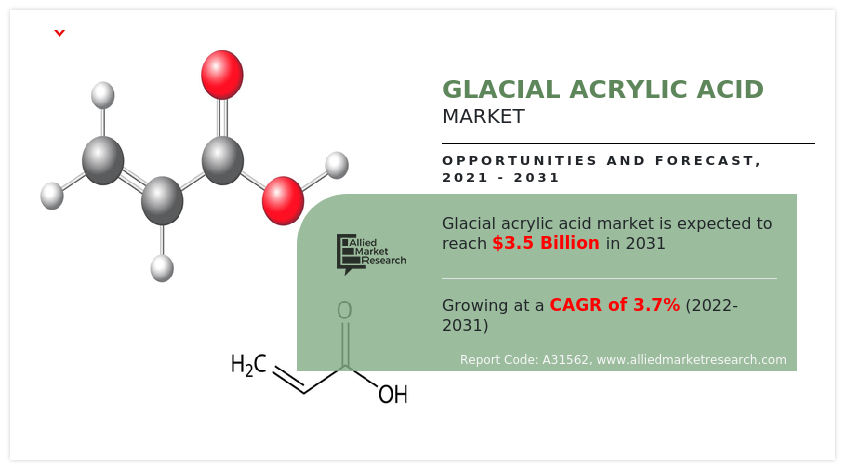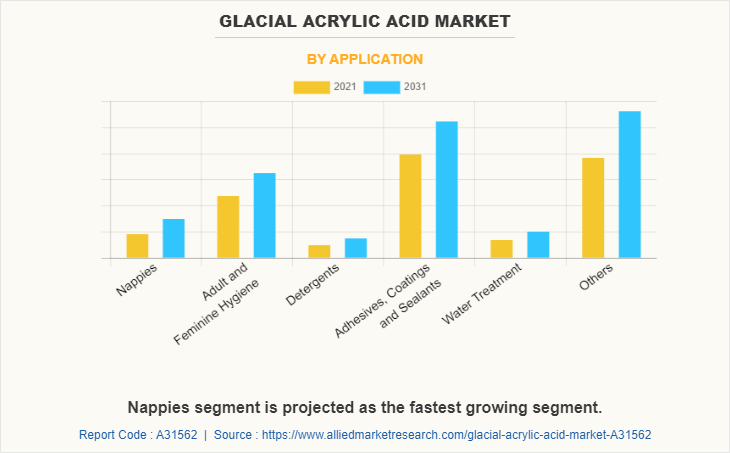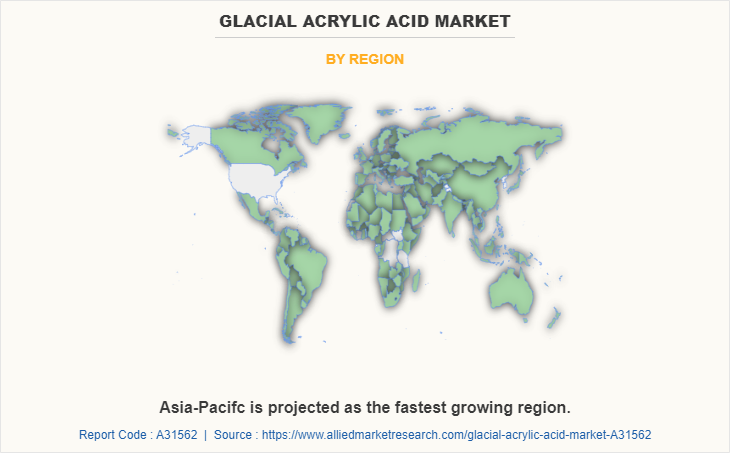Glacial Acrylic Acid Market Research, 2031
The global glacial acrylic acid market size was valued at $2.4 billion in 2021 and is projected to reach $3.5 billion by 2031, growing at a CAGR of 3.7% from 2022 to 2031.
Glacial acrylic acid (GAA) is a foul-smelling, clear, colorless liquid. It is extremely reactive. It has the chemical formula CH2=CHCOOH. GAA is manufactured through the catalytic oxidation of propene. GAA is used as a chemical intermediary in the production of mainly acrylate esters and acrylate salts. In addition, it is employed as a building block to create homo- and copolymers. Methyl acrylate and ethyl acrylate are formed principally through an acid-catalyzed esterification process of acrylic acid and alcohol, respectively. GAA possesses characteristics of acetic acids. The ability to create acid chlorides, salts, anhydrides, and esters is included. It also possesses double bond characteristics such as addition, polymerization, cyclization, and copolymerization.

During the forecast period, the market is anticipated to be driven by rising demand for GAA in the personal care sector because of its superabsorbent qualities. The increase in the production of surface coatings, surfactants, and adhesives & sealants in a number of emerging economies is also expected to stimulate market growth. Due to its strong affinity for addition reactions with numerous inorganic and organic compounds, GAA is also employed as a chemical intermediary to create other monomers by transesterification of molecules through chemical synthesis. Coatings, leather finishing, plastics, textiles, elastomers, thickeners, water treatment, adhesives & sealants, surfactants, fibers, inks, and pharmaceutical intermediates employ the resultant materials as ingredients. Consequently, the increase in the use of GAA as a chemical intermediate is expected to drive the GAA market during the forecast period.
The market is expected to be hampered by the volatility of propylene prices and the lack of adoption and awareness of GAA in developing nations. GAA must be stored in glass, stainless steel, or polyethylene containers because it is corrosive. As oxygen is required to activate the stabilizer, it must also be stored under an air atmosphere. GAA should not be stored for too long due to the irreversible production of dimers. These storage conditions are extremely expensive. Consequently, the significant costs connected with GAA storage and preservation can hinder the industry. Due to GAA's extreme toxicity and the global rise in environmental concerns, stringent regulatory restrictions have been imposed on its use. This is expected to have a negative impact on the market during the forecast period.
The primary trend in the market for glacial acrylic acid is the development of new technologies. The market's technology has undergone a paradigm shift as a result of effective R&D operations and an increase in investments by new and innovative market participants. Proprietary technology is a collection of interconnected tools, processes, or systems that are owned by a firm or an individual, offering a competitive advantage to the owners of proprietary technology.
By application, the market is segmented into nappies, adult & feminine, hygiene, detergents, adhesives, coatings & sealants, water treatment, and others Region wise, the market is studied across North America, Europe, Asia-Pacific, and LAMEA.
The major players operating in the global glacial acrylic acid market are Arkema, BASF SE, BASF PETRONAS Chemicals Sdn. Bhd., Dow Inc, Formosa Plastics Corporation, U.S.A, Hexion Inc., LG Chem, Mitsubishi Chemical Holdings Corporation, Nippon Shokubai Co Ltd, Novomer Inc, Sanmu Group, and Shandong Kaitai Petrochemical Co., Ltd. Other players operating in the glacial acrylic acid market include Cargill, Incorporated, Novozymes, and Sasol.
The glacial acrylic acid market is segmented into Applications and regions.

The adhesives, coatings, and sealants segment accounted for the largest share i.e., 32.5%, due to an increase in demand from the construction industry. The nappies segment is the fastest-growing segment, growing around 5.1% CAGR during the forecast period. This is due to the rise in demand for nappies from the personal care industry.

Asia-Pacific contributed 53.9% of the glacial acrylic acid market share in 2021 and is projected to grow at a CAGR of 4.2% during the forecast period, owing to increased demand for glacial acrylic acid from the construction and personal care industries.
Key Benefits For Stakeholders
- This report provides a quantitative analysis of the market segments, current trends, estimations, and dynamics of the glacial acrylic acid market analysis from 2021 to 2031 to identify the prevailing glacial acrylic acid market opportunities.
- Market research is offered along with information related to key drivers, restraints, and opportunities.
- Porter's five forces analysis highlights the potency of buyers and suppliers to enable stakeholders to make profit-oriented business decisions and strengthen their supplier-buyer network.
- An in-depth analysis of the glacial acrylic acid market segmentation assists to determine the prevailing market opportunities.
- Major countries in each region are mapped according to their revenue contribution to the global market.
- Market player positioning facilitates benchmarking and provides a clear understanding of the present position of the market players.
- The report includes an analysis of the regional as well as global glacial acrylic acid market trends, key players, market segments, application areas, and glacial acrylic acid market growth strategies.
Glacial Acrylic Acid Market Report Highlights
| Aspects | Details |
| Market Size By 2031 | USD 3.5 billion |
| Growth Rate | CAGR of 3.7% |
| Forecast period | 2021 - 2031 |
| Report Pages | 204 |
| By Application |
|
| By Region |
|
| Key Market Players | Mitsubishi Chemical Holdings Corporation, Nippon Shokubai Co Ltd, Shandong kaitai petrochemical Co., Ltd, Arkema, Hexion Inc., Formosa Plastics Corporation, Sanmu Group, Novomer Inc, BASF SE, LG Chem Ltd, DOW INC, BASF PETRONAS Chemicals Sdn. Bhd. |
Analyst Review
According to the perspective of the CXOs of leading companies, glacial acrylic acid market is expected to exhibit high growth potential during the forecast period. glacial acrylic acid offers notable advantages as a co-monomer in a variety of acrylic and vinyl acrylic polymer-based finishes, coatings, adhesives, sealants, finishes, inks, flocculants, thickeners, dispersion agents, lubricants, saturants, and plastics. Other applications for GAA in copolymers when combined with acrylamide co-monomer, include fracking systems, mining processing chemicals, detergent additives, water treatment chemicals, and superabsorbent materials (SAPs). In addition, glacial acrylic acid easily undergoes addition reactions with a wide range of organic and inorganic molecules. As a result, it serves as an extremely valuable feedstock for the production of numerous low-molecular molecules. For instance, propionic acid derivatives can be produced by using acrylic acid and water as well as alcohols, amines, halogens, and chlorinated hydrocarbons. Moreover, it can be combined with other chemicals to create heterocyclic compounds, products of the Diels-Alder addition, and unsaturated fatty acids.
Increasing demand from the wastewater treatment industry the upcoming trends of the glacial acrylic acid market in the world.
adhesives, coatings, and sealants are the leading application of the glacial acrylic acid market.
Asia-Pacific is the largest regional market for glacial acrylic acid.
The glacial acrylic acid market attained $2.4 billion in 2021 and is projected to reach $3.5 billion by 2031, growing at a CAGR of 3.7% from 2022 to 2031.
Arkema, BASF SE, Dow Inc, and Formosa Plastics Corporation are some of the top companies to hold the market share in glacial acrylic acid.
Increasing demand from various end-use industries like personal care, chemical, pharmaceutical, wastewater treatment, and coating is the key factor driving the demand for glacial acrylic acid market growth.
COVID-19 had a negative impact on glacial acrylic acid market growth owing to disrupted value chains and decrease demand from various end-use industries during the pandemic.
Loading Table Of Content...



